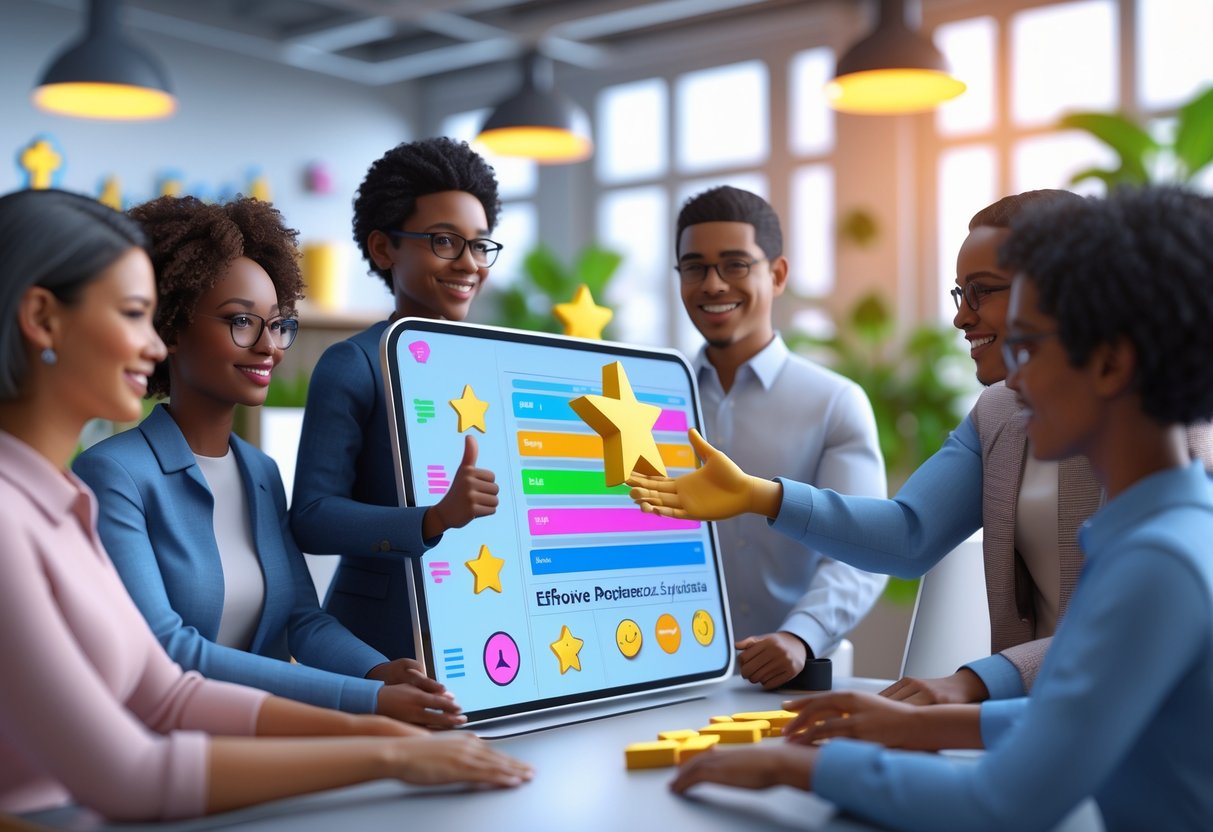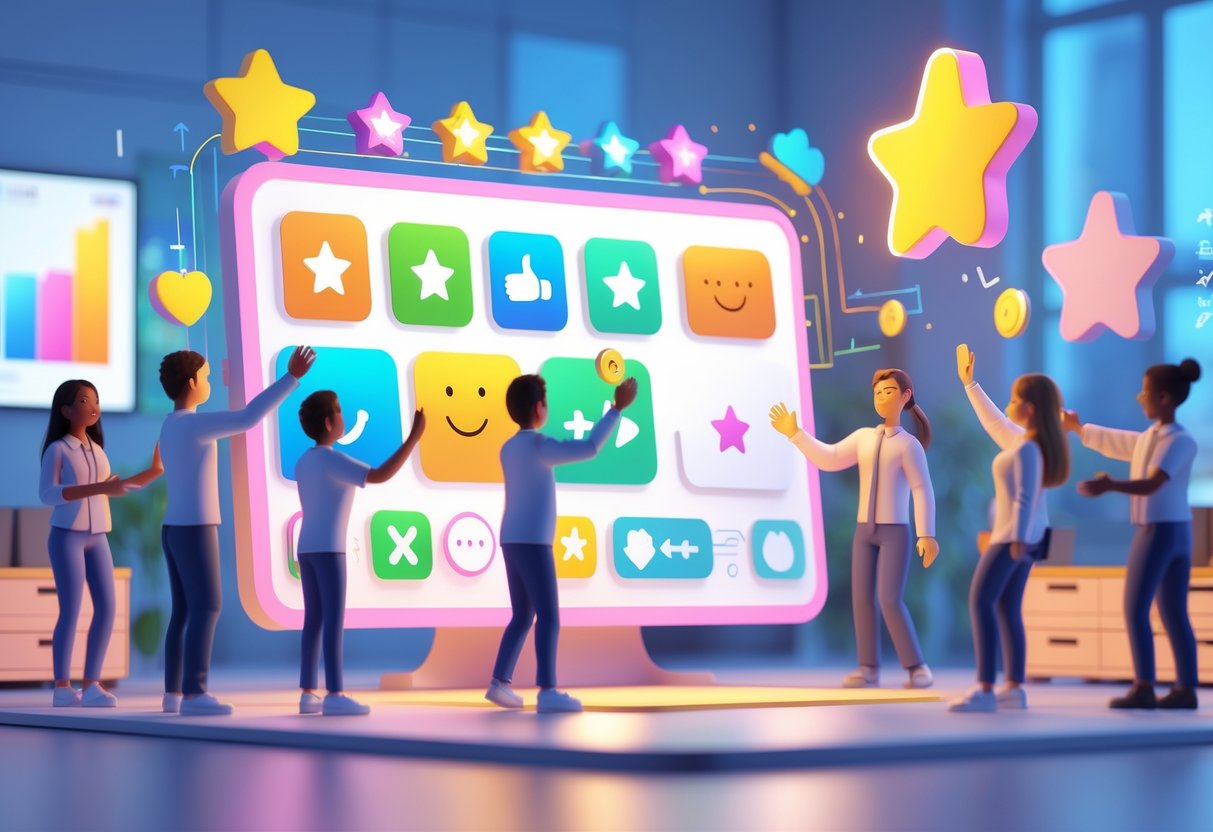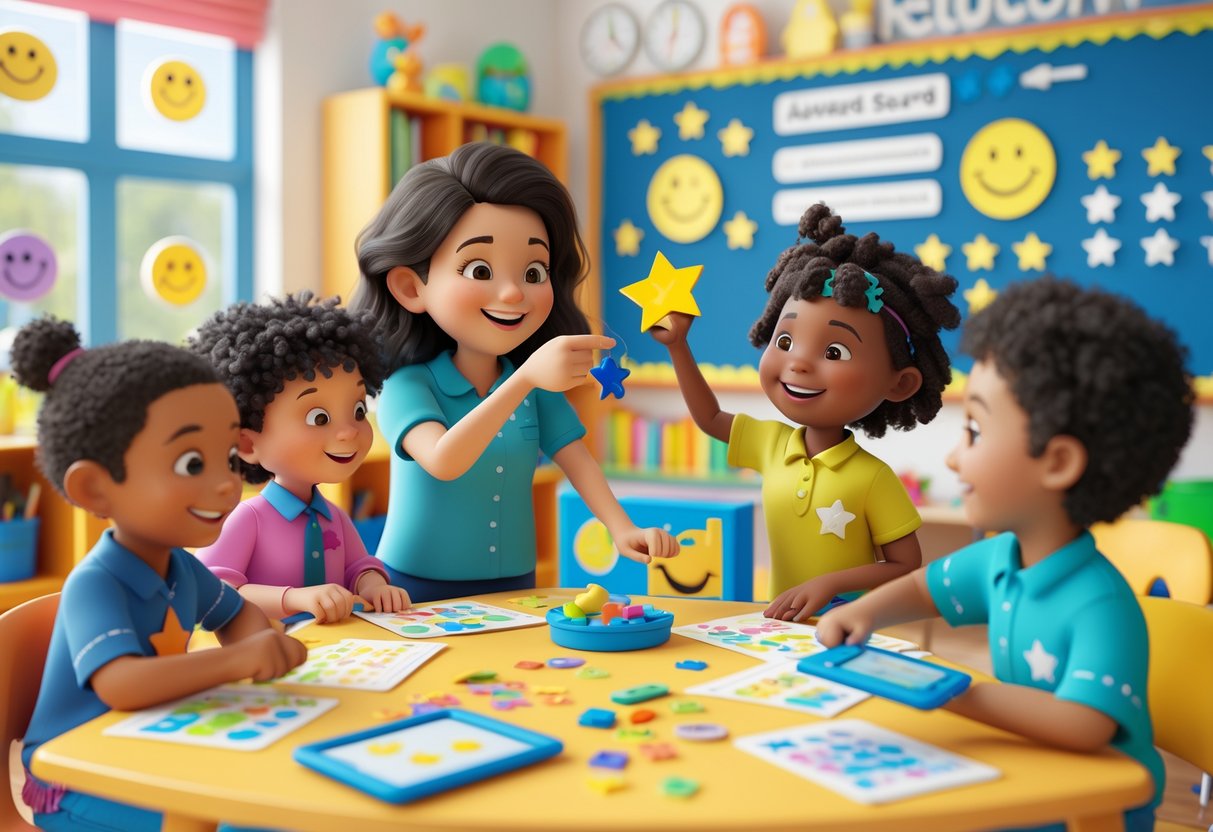Positive Reinforcement Systems: Practical Strategies for Lasting Behaviour Change
Updated On: August 23, 2025 by Aaron Connolly
Defining Positive Reinforcement Systems
Positive reinforcement systems encourage desired behaviours by introducing rewards right after those behaviours happen. When you use these systems, you focus on three main things: understanding the basics of behaviour change, knowing the difference between adding rewards and taking away unpleasant things, and building a reward structure that actually works.
Core Principles of Positive Reinforcement
Positive reinforcement means you add something good after a behaviour. This increases the chance that behaviour will happen again.
Timing is everything here. We need to reward people right after the behaviour, or the connection just gets weaker.
People naturally repeat actions that lead to good outcomes. If you look at behaviour patterns, you’ll spot this everywhere—kids tidy up for treats, employees push for bonuses.
Consistency helps a lot. Random rewards can work sometimes, but people do better when they know exactly what actions get them rewards.
The reward has to matter to the person. Some people light up at praise, others want something they can hold, and some just want an experience or a special privilege.
How Positive Reinforcement Differs from Negative Reinforcement
A lot of folks mix these up, but they’re not the same. Positive reinforcement means you give something pleasant after good behaviour. Negative reinforcement means you take away something unpleasant after good behaviour.
Think about it like this:
- Positive: A child gets £5 pocket money for doing chores (adding money).
- Negative: A parent stops nagging when the child does chores (removing nagging).
Both methods increase good behaviour, but the way they do it is different. Positive reinforcement builds motivation by making good experiences. Negative reinforcement works by taking away stress or discomfort.
Both approaches strengthen behaviour, but positive reinforcement usually feels better and helps create stronger habits.
Studies show positive methods tend to work better for long-term change. People remember good experiences and feel more motivated when they link good behaviour with pleasant results.
Key Components of Reinforcement Systems
A good reinforcement system needs four things working together. First, we have to clearly say which behaviours we want to see more often. Vague goals just confuse everyone.
Reward schedules decide when and how often we give rewards. We might reward every good behaviour, or just every third time, or maybe once a week. Different setups work for different goals.
The type of reward matters a lot. Here are some options:
| Reinforcer Type | Examples | Best For |
|---|---|---|
| Social | Praise, recognition | Most people |
| Tangible | Money, treats, gifts | Short-term goals |
| Activity | Extra privileges, fun tasks | Long-term motivation |
| Token | Points, stars, certificates | Complex behaviour systems |
How we deliver the reward makes a difference. Immediate rewards usually work best, but delayed ones can be okay if we explain when they’ll come. The person should always know exactly why they’re being rewarded.
We also need a way to track progress. Recording which behaviours happen and when we give rewards helps us see what’s working and what needs tweaking.
Fundamental Concepts of Reinforcement
Good reinforcement systems rely on three main things: picking the right type of reinforcement, sticking to proper timing, and choosing rewards that actually motivate the person.
Types of Reinforcement Methods
Applied behavior analysis points out a few different reinforcement methods, and each one encourages positive behaviours in its own way. Knowing these types helps us build better systems based on real evidence.
Social reinforcement uses human interaction as the reward. This could be praise, high-fives, smiles, or just attention. A lot of people respond well to social reinforcement because we all crave connection.
Tangible reinforcement is about physical things like toys, food, money, or certificates. These rewards work especially well when someone’s learning something new. The item has to be something the person actually wants.
Activity reinforcement gives access to favourite activities or experiences. Think extra playtime, picking a game, or going somewhere special. Sometimes, activity rewards just feel more natural.
Token systems use symbolic rewards, like points or stickers, that you can trade in for something bigger. These systems help bridge the gap between wanting a reward now and working toward something later.
Frequency and Schedules of Reinforcement
How often and when we give rewards makes a huge difference. We can use different schedules depending on our goals.
Continuous reinforcement means giving a reward every single time the good behaviour shows up. This is great for learning something new because it builds a strong link.
Intermittent reinforcement means you only give rewards some of the time. This actually keeps behaviours going longer. People stay motivated even if they don’t always get a reward right away.
| Schedule Type | When to Use | Advantages |
|---|---|---|
| Continuous | Learning new skills | Quick learning, clear connection |
| Fixed ratio | Consistent work output | Predictable, steady performance |
| Variable ratio | Long-term maintenance | High motivation, resistant to extinction |
| Fixed interval | Time-based goals | Regular check-ins, scheduled progress |
The best systems usually mix things up. You might start with continuous reinforcement, then slowly switch to intermittent as the behaviour sticks.
Selecting Appropriate Reinforcers
Picking the right reward can make or break your system. What gets one person excited might do nothing for someone else.
We have to look at what each person actually likes. Some people want recognition, others want things, and some just want to do something fun.
Age matters too. Little kids usually want something they can get right away. Older people might care more about social rewards or special activities.
Culture plays a role. Family values, background, and beliefs all shape what feels rewarding. Something that’s a big deal in one culture might not work at all in another.
We also need to pick rewards we can actually deliver. If it’s too hard or expensive to give the reward every time, it’s just not going to work. Simple, easy-to-give rewards often do the job.
Try different things and see what works. Offer choices and watch what gets the best response.
The Role of Positive Reinforcement in Behaviour Change
Positive reinforcement leads to real behaviour change by rewarding the right actions as soon as they happen. This approach builds good relationships and slowly reduces tough behaviours by always recognising the good stuff.
Strengthening Desired Behaviours
When we add something valuable right after a behaviour, we make that action stronger. The connection between the action and the reward gets clearer.
Timing here is huge. We need to give the reward within seconds, or people just won’t link it to their behaviour.
Everyone’s different. Some want praise, others want activities or items. We have to pick rewards that each person actually cares about.
Consistency really helps. If we reward the same behaviour every time in the beginning, people learn fast. Later, we can reward less often to keep things going.
The size of the reward should match the effort. Small wins get small rewards. Big changes deserve more.
Reducing Challenging Behaviours
Positive reinforcement makes good choices more appealing and can push out problem behaviours. When people get attention and rewards for doing well, they have less reason to act out.
We don’t just ignore the tough behaviours. Instead, we put way more focus and attention on the good stuff.
Corrective feedback works best when we pair it with positive reinforcement. We point out the problem quickly, then highlight any positive behaviour we spot.
Teaching replacement behaviours matters a lot. If someone lashes out when frustrated, we show them how to ask for help instead, then we reward that.
A lot of problem behaviours happen because people want attention or to escape something hard. When we give attention for the right behaviour and make tasks easier, the tough behaviours usually fade away.
Building Positive Relationships
Positive interactions get stronger when we focus on spotting the good moments instead of always correcting mistakes. This builds trust and teamwork.
People put in more effort for those who notice and appreciate what they do. When we regularly call out someone’s good choices, they want to keep it up. It just makes change easier.
Celebrating progress together creates shared experiences and memories. These moments fuel motivation for the long haul.
When people see that good behaviour leads to good outcomes, they start making better choices even when no one’s watching.
Having a strong relationship makes it easier to give feedback when things go wrong. People take advice better from someone who also cheers for their wins.
Positive Reinforcement in Educational Settings
Schools use positive reinforcement to shape better learning environments and help students succeed. This approach works in individual classrooms and across whole schools by rewarding both good behaviour and academic effort.
Classroom Applications and Strategies
Teachers use all sorts of positive reinforcement to encourage student behaviours that help learning. The go-to method is verbal praise. You’ll hear things like “great job” or “I love how you solved that problem”—these little comments can boost motivation right away.
Social reinforcers work especially well with younger kids. These might be:
- Written comments on their work
- Smiles or nods
- High-fives or thumbs up
- Showing off student work
Activity-based rewards let students earn time for their favourite activities. Maybe it’s computer time, a library visit, or working with a friend. This not only rewards them but often brings in some social fun too.
Token systems keep track of progress over time. Students collect points, stickers, or tickets and trade them for bigger rewards later. This teaches them to wait for good things while still staying motivated day-to-day.
For special education students, rewards often need to be more immediate and specific. Teachers might use visual charts or give out small tangible rewards that connect directly to the behaviour.
Research says students pay attention about 93% of the time when teachers use positive reinforcement consistently. That’s a pretty impressive number.
Whole-School Reinforcement Systems
A lot of schools run positive behaviour support programs that cover all classrooms and shared spaces. These systems set up clear expectations and rewards everywhere in the building.
House point systems are a big deal in UK schools. Students earn points for their house by showing good behaviour, getting good grades, or helping out. It’s a friendly competition that also builds a sense of community.
Recognition assemblies let schools celebrate achievements in front of everyone. Whether it’s academic progress, good citizenship, or better behaviour, these moments show all students what’s valued.
Merit certificates and awards give formal recognition students can show their families. These are great for kids who respond to outside validation.
Behaviour tracking systems help schools spot patterns and celebrate progress. Digital tools let teachers log positive behaviours that count toward school-wide rewards.
Whole-school approaches work best when everyone uses the same language and rules for rewards. This way, students know what to expect, no matter which teacher or room they’re in.
Supporting Positive Student Behaviours
Effective reinforcement works best when it targets specific behaviours, not just general praise. So, instead of a vague “good job,” educators could say, “You showed excellent problem-solving by trying three different methods.”
Timing makes a big difference. Students—especially younger ones—need recognition right after they show the behaviour you want. If you wait too long, the impact just fades away.
Choosing age-appropriate rewards keeps reinforcement effective. Primary students usually love stickers and certificates, while secondary students seem to prefer privileges or recognition from their peers.
When students struggle with challenging behaviours, teachers plan reinforcement schedules carefully. They might start with frequent rewards and then stretch out the intervals as things improve.
Individual recognition can boost personal motivation. On the other hand, group rewards encourage collaboration and support among peers.
Letting students help choose their own rewards makes the whole process more meaningful. When they pick what matters to them, they’re much more invested in earning it.
There’s no one-size-fits-all answer. Matching the reinforcement to each student’s needs and preferences matters most. What fires up one student might do nothing for another, so flexibility is key.
Delivering Effective Praise and Feedback

Good feedback helps players improve faster and strengthens team bonds. Praise should be specific, balanced with useful corrections, and—above all—genuine.
Crafting Praise Statements
Effective praise spells out what someone did right. Rather than a bland “good job,” we should highlight the behaviour we want to see again.
A strong praise statement usually has three parts. First, use the player’s name to grab their attention. Next, describe exactly what they did well. Finally, explain how it helped the team.
For example: “Sarah, that call-out about the enemy position saved our round because it let us rotate quickly.” That feels a lot more meaningful than just “nice call.”
Verbal reinforcement works best when it happens right after good play. Praising effort and improvement—not just wins—keeps players motivated, even when things get tough.
| Weak Praise | Strong Praise |
|---|---|
| “Well done” | “Jake, your ward placement gave us vision control for that team fight” |
| “Great game” | “Emma, staying calm under pressure helped you land that clutch shot” |
| “Keep it up” | “Tom, your communication about cooldowns let us time our push perfectly” |
Balancing Praise and Corrective Feedback
Good coaching mixes positive feedback with helpful corrections. Most players need more praise than criticism to keep their confidence up.
Corrective feedback should target specific actions, not personal traits. So, say “your positioning left you exposed” instead of “you always make bad choices.”
Start with praise, then suggest improvements. For example: “Your aim was spot-on in that fight. If we work on your movement between cover, you’ll be even harder to catch.”
Timing matters for corrections too. Try not to give feedback during high-pressure moments unless it’s urgent. Most detailed discussions go better between rounds or after matches.
Ensuring Authentic Positive Interactions
Players notice when praise isn’t genuine. It’s important to mean what you say and recognize real achievements, even if they’re small.
Positive interactions build trust over time. Celebrate individual progress along with team wins. If a player finally nails a tough technique, that deserves recognition—even if the team loses.
Match your tone to the achievement. A basic skill? Quiet encouragement works. Pull off something tricky? That’s worth a bigger celebration.
Every player is different. Some love public praise, while others prefer a private word. Good coaches learn what motivates each team member and adjust how they give feedback.
Types of Incentives and Rewards

Different rewards work for different people and situations. It’s all about matching physical prizes with social recognition, giving people new roles, and picking rewards that fit someone’s age and skill level.
Tangible vs. Intangible Rewards
Tangible rewards are the physical things you can see and keep—stickers, certificates, small toys, or gift cards. Kids usually love these because they’re something they can hold and show off.
Token systems work well in classrooms. Students collect points or tokens to trade for prizes later. It helps them learn to work toward bigger goals instead of craving instant rewards.
Intangible rewards focus on experiences and feelings. Praise from teachers, extra free time, or choosing the next class activity all count. These rewards often build intrinsic motivation better than physical prizes.
Social recognition can be surprisingly powerful. Being named “Student of the Week” or having your work displayed for everyone to see makes a lot of people feel proud. This kind of positive reinforcement costs nothing but can motivate people just as much as any prize.
The best reward systems usually mix both types. Start with tangible rewards to get attention, then add more praise and recognition over time.
Opportunities for Responsibility
Giving people new responsibilities as rewards taps into their need to feel important and trusted. This works for students, employees, and even kids at home.
In schools, responsible students might become classroom helpers or peer tutors. These roles help them feel valued and let them support others.
Workplaces offer incentives like leading projects or mentoring new staff. These opportunities help people grow and contribute more to the team.
At home, kids might earn the chance to help cook dinner or pick the family film. These rewards teach life skills and show trust in their abilities.
Age matters with these rewards. Young kids might water plants or feed pets. Teens could manage budgets for school events or lead team projects.
Considerations for Age and Development
Younger children need immediate, simple rewards they can understand right away. Stickers, treats, or extra playtime work well because they’re easy to grasp.
Primary school kids can handle slightly delayed rewards and simple point systems. They’re starting to understand that good work now leads to fun stuff later.
Teenagers usually care more about social recognition and real-world incentives. They want respect from peers and chances to show independence. Gift cards, extra privileges, or leadership roles motivate them more than stickers.
Adults need rewards that match their personal values and goals. Some want public recognition, while others prefer private feedback or chances to advance their careers.
Timing changes with age, too. Young kids need immediate feedback, but older folks can work toward monthly or yearly goals just fine.
Group Contingencies and Peer Influence

Group contingencies set up shared goals so students work together for rewards. These systems use peer influence to boost positive behaviours throughout the class.
Implementing Group-Based Reinforcement
Group-based reinforcement connects individual actions to group outcomes. When you use these systems, the whole class or team earns rewards based on how the group does.
There are three main types:
- Independent: Each student earns rewards for themselves but follows the same rules.
- Dependent: The whole group’s reward depends on specific students’ behaviour.
- Interdependent: Everyone must contribute for the group to succeed.
Goals need to be clear and measurable—something like “90% homework completion rate” instead of “work harder.”
Some best practices:
- Make reinforcers fun and age-appropriate.
- Pick rewards that aren’t available elsewhere.
- Keep costs low for teachers.
- Make sure rewards are easy to give out and track.
Visual tracking helps students see progress. Charts, thermometers, or digital displays all work well for showing achievements.
Harnessing Positive Peer Influence
Peer influence gets powerful when you set it up right. Students naturally want to fit in and avoid letting their team down.
Positive peer pressure grows when students cheer each other on, celebrate individual contributions, and everyone has a role in group success. Social recognition should come from the right actions.
We need to guard against negative dynamics like scapegoating. Set achievable standards and focus on improvement, not perfection.
Students learn to support classmates who struggle instead of blaming them. They start to pick up helping behaviours and collaborative skills naturally.
Some key strategies:
- Teach students how to give positive feedback.
- Create chances for peer coaching.
- Celebrate effort as well as achievement.
- Build in safeguards against negative peer pressure.
The social side makes these systems more engaging than just individual rewards.
Examples of Group Contingencies
The Good Behaviour Game splits classes into teams that compete for the fewest rule violations. Teams that meet the criteria get privileges or fun activities.
Whole-class token systems let students earn points together. When the class hits the target, everyone enjoys something special, like extra playtime or a movie.
Mystery motivator systems add excitement with unknown rewards. Students work toward goals without knowing exactly what they’ll earn, which keeps motivation high.
| System Type | Target Behaviour | Typical Reward |
|---|---|---|
| Homework completion | 85% class completion rate | Extra break time |
| Transition speed | Under 2 minutes | Preferred activity |
| Helping behaviours | 5 acts per day | Class celebration |
Caught Being Good programmes focus on positive recognition. Teachers hand out points when they spot good decisions, skipping punishment for mistakes.
Some schools use house systems where students earn points for their assigned groups all year. This builds long-term investment in positive behaviour.
These examples work because they make good behaviour socially rewarding and help build community.
Motivational Systems and Behaviour Management

Managing behaviour well means using several motivation strategies together. The best systems blend intrinsic motivation with smart reinforcement to help changes last.
Integrating Motivation into Reinforcement Systems
Motivation drives behaviour in three ways: approach motivation (chasing rewards), avoidance motivation (dodging negative outcomes), and assertion motivation (keeping up good habits).
Approach motivation works best at the start of behaviour change. Students respond to immediate, tangible rewards that make good actions feel positive.
Avoidance motivation helps keep unwanted behaviours in check. Clear consequences and structured environments make it easier to avoid temptations.
Assertion motivation matters most for long-term maintenance. Once new behaviours stick, this keeps them going without constant rewards.
| Motivation Type | Best Use | Example |
|---|---|---|
| Approach | Starting new behaviours | Points for participation |
| Avoidance | Reducing problem behaviours | Loss of privileges |
| Assertion | Maintaining habits | Self-monitoring systems |
Combining Behaviour Management Strategies
Three approaches work best together.
Facilitating gives external resources and support. This means clear instructions, the right materials, and tweaks to the environment that make success easier.
Boosting builds up internal skills. We help students learn self-regulation, set goals, and become more aware of how they think.
Nudging taps into emotions. This means making positive behaviours feel good and building strong associations.
The most effective programmes use all three. You might give clear rubrics (facilitating), teach self-assessment (boosting), and create celebration rituals (nudging).
Supporting Sustained Engagement
Long-term success means shifting from outside rewards to internal motivation. Student engagement changes over time.
At first, engagement relies on external motivators. Clear rules, quick feedback, and consistent rewards help set new patterns.
Over time, students develop more autonomy. We give them choices, encourage self-directed learning, and let natural consequences guide behaviour.
Sustained motivation happens when students feel capable, independent, and connected. The focus moves from just following rules to truly engaging with learning.
It’s important to keep an eye on engagement and tweak your approach as needed. Some students need extra support before they build internal motivation.
Applying Positive Reinforcement in Special Education

Special education classrooms need reinforcement systems that actually fit each student’s learning profile and behaviour needs. Success really comes down to personalising approaches for all sorts of abilities, tackling tough behaviours with research-backed strategies, and teaming up with therapists and families.
Tailoring Reinforcement for Diverse Needs
It’s important to recognise that students with special educational needs react differently to reinforcement. For example, a student with autism might love tangible rewards like stickers, while a student with ADHD might do better with activity-based reinforcement—think movement breaks.
Social reinforcement works for many students. Verbal praise, high-fives, or even a simple smile can go a long way. But some students with sensory issues might find physical contact overwhelming, so we have to watch for that.
We use token economy systems pretty often. Students earn tokens for finishing tasks or following rules, then swap them for activities or items they like.
Edible reinforcement can help motivate certain behaviours, like task transitions. Of course, we always check dietary restrictions and chat with families to make sure it’s okay.
The real trick is individualisation. What fires up one student might fall flat for another. We keep an eye on each student’s reactions and tweak our approach as needed.
Addressing Behavioural Challenges
We rely on applied behaviour analysis principles when facing challenging behaviours in special education. We give immediate reinforcement so students connect their actions to positive outcomes.
Consistency matters a lot. If we apply reinforcement strategies randomly, students get confused about what earns rewards. Everyone on the team needs to stick to the same approach.
We try to avoid over-reliance on external rewards by gradually moving from tangible items to social reinforcement. This helps students build up their own motivation over time.
Timing is everything. If we wait too long to give reinforcement, students lose the link between behaviour and reward. We give feedback right after the good behaviour happens.
Some students show attention-seeking behaviours. We focus on reinforcing positive ways to get attention and avoid accidentally rewarding negative behaviours.
For students who struggle with communication, we bring in visual reinforcement systems. Picture cards or charts make expectations clearer and help them track progress.
Collaborating with Specialists
We team up with speech and language therapists to reinforce communication goals throughout the day. Sometimes that means celebrating any effort at verbal communication or using visual aids.
Occupational therapists help us understand sensory needs. Some students need sensory breaks as rewards, while others might get overwhelmed by certain sounds or textures during reward time.
Educational psychologists guide us on behaviour intervention plans. They help us look at challenging behaviours and come up with the right reinforcement schedules.
Families play a huge role. We share what works at school so parents can try similar strategies at home. Keeping things consistent between home and school really helps.
Teaching assistants get training on reinforcement techniques too. They learn to spot chances for positive reinforcement and deliver it throughout the day.
We set up regular review meetings with the whole team. These meetings let us check how well our reinforcement systems are working and make changes based on student progress.
Evaluating and Improving Reinforcement Systems

Reinforcement systems don’t run themselves. We need to check in regularly, see how students respond, swap out rewards that fall flat, and use real data to steer our decisions.
Monitoring Behavioural Progress
If we don’t measure, we can’t improve. Tracking student behaviour gives us proof that our system works—or doesn’t.
Daily tracking methods let us spot patterns quickly. Simple charts that show positive behaviours each day work well. We can mark when students follow rules, help others, or finish tasks on time.
Weekly reviews help us see bigger trends. Maybe students behave better on Mondays but struggle on Fridays. This info helps us plan support.
Key behaviours to track:
- Following classroom rules
- Completing assignments
- Helping classmates
- Staying focused in lessons
- Using respectful language
Digital tools make tracking easier. Apps send quick alerts when students earn points. Teachers can update records in seconds.
Behaviour analysis points out which students need more help. If some students never earn rewards, we know it’s time to try something different.
Adjusting Reinforcers for Effectiveness
What excites students in September might bore them by January. We have to keep rewards fresh to keep students interested.
Signs reinforcers need changing:
- Students stop trying for rewards
- Behaviours get worse
- Only a few students respond to current rewards
- Teachers struggle to give feedback
Different students want different things. Year 7s might love stickers, but Year 10s usually prefer extra break time. When we can, we offer choices.
Effective reward adjustments:
- Social rewards: Praise, certificates, positive calls home
- Activity rewards: Extra computer time, picking music, helping the teacher
- Tangible rewards: Small items, treats, or privileges
We try out changes slowly, starting with one class. If it works, we roll it out to others.
Getting feedback from students helps a lot. Quick surveys like “What would motivate you?” give us new ideas.
Collecting and Using Data
Good data takes the guesswork out of decision-making. We need simple systems teachers will actually use every day.
Essential data to collect:
- Number of positive behaviours daily
- Which rewards students pick most
- How quickly behaviours improve
- Which times of day are best
Simple tracking sheets beat complicated forms. Teachers can tick boxes between lessons. Digital systems that sync across devices save even more time.
Weekly data reviews help us catch problems early. If positive behaviours drop for a few days, we know to act.
| Data Type | Collection Method | Review Frequency |
|---|---|---|
| Daily behaviour counts | Quick tick sheets | Daily |
| Reward preferences | Student surveys | Monthly |
| System effectiveness | Behaviour graphs | Weekly |
| Teacher feedback | Brief meetings | Fortnightly |
Reinforcement works best when we let the data guide us. The numbers show us what actually helps students succeed.
We should show students their positive data too. Progress charts can boost motivation. Students feel proud when they see how much they’ve improved.
Data collection shouldn’t take over teaching. Quick methods that fit into the daily routine work best.
Common Challenges and Solutions in Positive Reinforcement

Even the best reinforcement systems can run into trouble. Getting the right balance between rewards and real motivation—while keeping things consistent—takes some ongoing effort.
Avoiding Over-Reliance on External Rewards
Sometimes students only behave to snag prizes or treats. They stop caring about doing the right thing and just chase the next reward.
Signs of over-reliance:
- Students ask “What do I get?” before tasks
- Good behaviour drops when no rewards are on offer
- Learners lose interest in activities they used to like
We can fix this by mixing up the types of rewards. Social praise works well and doesn’t build dependency. Try saying “You worked really hard on that” instead of just handing out stickers.
Gradual fading strategies:
- Start with immediate rewards for new behaviours
- Slowly increase the time between behaviour and reward
- Move from prizes to praise and recognition
- Let students set their own goals and celebrate progress
Teaching students to feel proud of their work is the real win. When they start caring about their achievements without needing a prize, we’ve built something that lasts.
Addressing Inconsistencies in Implementation
Mixed messages from different staff can confuse students and break down behaviour support. If one teacher praises something another ignores, students aren’t sure what to expect.
Common consistency problems:
- Different reward systems in each classroom
- Some staff forget to give positive feedback
- Unclear rules about which behaviours earn rewards
- Delays between behaviour and recognition
Create simple, clear guidelines for everyone. Write down exactly which behaviours get rewarded and how quickly recognition should happen.
Solutions for better consistency:
- Train all staff on the same methods
- Use visual reminders like charts or apps
- Hold weekly team meetings to share what’s working
- Set up buddy systems for teacher support
Regular check-ins help us catch problems early. When the team sticks to the same plan, students feel more secure and respond better.
Promoting Intrinsic Motivation
The goal? Helping students want to do well because it feels good, not just for external rewards. Intrinsic motivation grows when learners feel capable, independent, and connected to their work.
Give students choices about their learning when possible. Let them pick project topics or decide how to show what they’ve learned. This builds ownership and personal investment.
Ways to build internal motivation:
- Praise effort, not just natural ability
- Help students set their own goals
- Connect work to their interests and future plans
- Encourage reflection on personal growth
Ask questions like, “How did that make you feel?” or “What are you most proud of?” These help students notice their own positive feelings about success.
Supporting autonomy with structure:
- Offer choices within clear limits
- Let students track their own progress
- Encourage peer support and collaboration
- Celebrate learning from mistakes, not just getting it right
When students build intrinsic motivation, they keep going even when things get tough. They become lifelong learners who don’t need constant rewards.
Frequently Asked Questions

Teachers, parents, and education professionals often have questions about how to actually put positive reinforcement systems into practice. People want to know about practical strategies, research-backed benefits, age-appropriate techniques, and how positive reinforcement stacks up against other behaviour management options.
What are the key benefits of applying positive reinforcement strategies in educational settings?
Positive reinforcement encourages students to repeat good behaviours. Unlike punishment-based systems, it builds confidence and motivation in a more natural way.
Studies show positive reinforcement boosts student engagement and academic performance. Students feel better about themselves when they get recognition for their efforts.
Classroom behaviour usually improves when teachers use consistent positive reinforcement. Students learn social skills and build stronger relationships with their teachers and classmates.
Challenging behaviours tend to decrease over time. Students who get positive feedback for good choices are less likely to act out.
How can teachers effectively implement positive reinforcement in their daily classroom activities?
Start by picking specific behaviours you want to see more often. Clear expectations help students know what earns positive recognition.
Give feedback right away when students show the desired behaviour. Quick responses make the connection stronger.
Mix up reinforcement methods to keep things interesting. Praise, privileges, tokens, and favourite activities all work.
Stay consistent with all students and situations. Fairness builds trust and keeps the system effective.
Track progress with simple tools. Notice which students respond to which types of reinforcement and adjust as needed.
Could you provide some examples of positive reinforcement techniques that support student engagement?
Verbal praise works for most students, especially when it’s genuine. Saying something specific like “Great job showing your working in maths” is better than a generic “Good job.”
Token systems let students earn points or stickers for good behaviour. They can trade these for activities or privileges.
Preferred activity time is a big motivator. Extra computer time, library visits, or helping the teacher can keep students on track.
Social recognition—like class announcements or certificates—lets students feel seen by their peers. Lots of students value this.
Giving students choices reinforces good behaviour and builds independence. When students earn choices, they feel more invested in their learning.
In what ways does positive reinforcement differ from negative reinforcement, and how does each impact student behaviour?
Positive reinforcement adds something good after a student behaves well. That could be praise, privileges, or a reward.
Negative reinforcement takes away something unpleasant when students behave. For example, cancelling homework for good participation or ending detention early for cooperation.
Both methods increase desired behaviours, but they work differently. Positive reinforcement builds motivation, while negative reinforcement provides relief.
Positive reinforcement usually leads to more lasting results. Students start to feel good about their achievements and keep trying.
Negative reinforcement can make students depend on avoiding consequences. They might behave just to dodge something, not because they actually want to do well.
What research exists to support the effectiveness of positive reinforcement in educational psychology?
Researchers have found that positive reinforcement works well across all sorts of age groups and settings. The data points pretty clearly to better academic results and fewer behavioral issues.
B.F. Skinner, with his operant conditioning experiments, really drove home how positive reinforcement can change behavior quickly and for the long haul. His work still shapes how teachers use these strategies today.
Schools that use behavior intervention plans based on positive reinforcement tend to see strong results. When teachers reward replacement behaviors, even students with tough challenges seem to respond.
Meta-analyses suggest positive reinforcement usually outperforms punishment-based methods. Classrooms that focus on encouragement and rewards often see kids more engaged and making real academic strides.
Interestingly, research shows that how consistently teachers use positive reinforcement matters a lot. Schools that actually train staff in these methods get better outcomes than those just winging it.
How might positive reinforcement be adapted for different age groups within a school environment?
Primary school students usually respond best when you give them immediate, tangible rewards. Stickers, stamps, and little privileges? Those are often a hit with younger kids.
Secondary students, on the other hand, seem to care more about social recognition or extra privileges. If you let them earn free time, pick their seats, or take on special responsibilities, that can really motivate them.
You should adjust how often you give out reinforcement depending on the student’s age and skill level. Younger students need rewards more frequently, while older ones can handle working toward longer-term goals.
Think about what each age group actually likes. Primary students love games and activities, but secondary students? They tend to value access to technology or more social opportunities.
It’s important to individualize your approach based on each student’s preferences and cultural background. What motivates one student might not do much for another, no matter how old they are.

